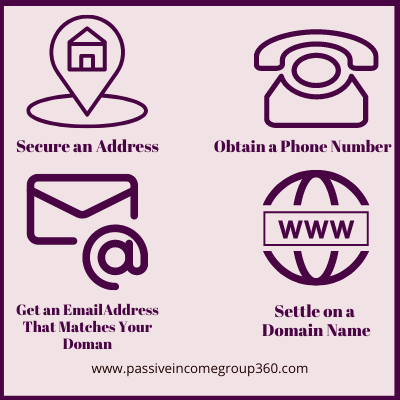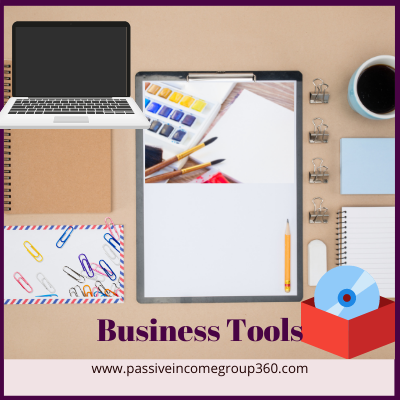
Digital Product Ideas
If you’re interested in making money online and are wondering what to sell, these are profitable digital product ideas that you can use to start or grow your business.
The idea of starting an online business can sound very glamorous. Setting your own hours. Being able to spend time with family when you like. Working on something you love. The freedom and flexibility that come with self-employment are definitely a plus. You are your own boss and can finally call all the shots.
The feeling you get when you know someone is enjoying your service or product is very gratifying. But before we can get to the perks, let’s take a look at the steps you have to take to be sure your business is set up for success. Success is the goal, right? So look at it as a foundation of your online business.
Make it sturdy and you’re setting yourself up the right way from the start, regardless of what may come your way.
Not every step will be necessary for every business, but I’ve included steps that most new online businesses offering a product or service will need to take.
Of course, you should feel free to rearrange the order so you do things in a way that makes sense to your business, but it’s a good framework that should get you thinking about the steps you need for your particular business. There are 17 steps listed here but many of the steps can be completed from home in one day. So roll up your sleeves, get a drink, and let’s see what may lie ahead.
This is a given, right? The first step is to take a look at your interests, talents, income goals, and the demand for your product or service. If you have an idea of the type of online business you would like to start, awesome!
If you don’t know and need a little help deciding what type of business to start, try this profit from your passion workshop. This is a free 3-day course designed to help you choose a winning online business. In the course, you’ll walk through the easy steps that will help you identify the perfect business type for you. It works!

Research and Identify Your Niche (If applicable). A niche is simply a smaller segment of the population or a more specific type of product or service. It’s usually something that is particularly relevant to a certain group of people, as opposed to the general population. Tall women, tweens, military spouses, and coffee lovers are examples of niches.
Once you know what kind of business you want to start, think about your target audience, or niche. Chances are it will be easier for you to market your product or service to a specific group of people than to the entire population. Especially when you’re starting out, it’s better to be a big fish in a small pond than a small fish in a big pond.
If it makes sense for your business, target a niche that you are familiar with. This will make marketing and product development a lot easier. Who would know what kind of knitting course to offer better than someone who knits? Your niche are going to be your people so be sure to choose a niche you don’t mind spending lots of time on.
Identify And Write Out a Roadmap To Your Launch. Create a roadmap for yourself from start to finish with a good business plan. Decide when you want to launch and work backward so you know how much time you’ll need to meet each milestone. Be sure to remain realistic with your business plan.
Wanting to launch in a week is very different from being able to with every piece in place. Give yourself time keeping in mind your other obligations and things like holidays where certain offices you need may be closed.
If you have an audience or any social media presence you can even create a buzz ahead of your launch so people will be ready to support your new business once it’s open for business. A business plan will also help you hold yourself accountable. No more delaying and procrastinating. People are expecting greatness and you promised to deliver!
If you don’t already have a name for your business it’s important to decide on that early on. Think long and hard about the name because you’ll be building everything else on this foundation. Same goes with brand identity.
Do you have a slogan or logo you want to use? Are there particular colors you would like for your brand? What about a certain font for your print material? At the very least decide on the name now because as you’ll see in the next few steps, you’ll need them. The other things you can think about a little longer.
Look at fonts on magazines, blogs, websites to get an idea of the type of font you’d like. Each one has a different feel, and depending on your type of business, some will work better than others. The same goes for your brand colors. Certain colors are said to evoke emotions that you may or may not want your ideal customer or client to feel. Do a little research to see which will represent your brand identify the best.
Also, if you plan to have someone design a logo or other branding for you, be sure to include the time it will take to develop these into your launch plan. You can always change the business name and logo later but it’s better to choose one and stick with it to create consistency with your audience and brand identity.
Secure a Domain Name And Claim Social Media Username. Now it’s time to commit to that brand name! The domain name is just the name in between “www.” and “.com”, typically the name of your business, brand, or something related to either. Try to think of one that is easy to recall, not too long to type, and that will help you get found in Google search.
If you plan to use your name as a domain that’s fine, but if you want to use another name try to use one that tells people what you’re about if you can. For example, a domain name such as www.goodvibesallaround.com would not tell you what my business is about. Something like www.goodvibescoffee.com would let you know that my business sells coffee, maybe with a smile!
Even if you’re ready to create a website just yet, it’s wise to secure a domain name now. Try going to a website like Godaddy or Bluehost and check to see if your ideal domain is available and snag it if you can. The same goes for social media handles.
Even if you don’t plan to start promoting your business on social media now, secure your name on each platform that you may want to use later. You’ll be glad you did. Bluehost has a great deal on domains and web hosting with sites like WordPress.org when you’re ready.


Depending on whether you plan to work from home or from an office, it’s wise to secure your business address and phone number. The same goes for your email address. The address doesn’t have to be a physical address, per se, but you will need a business address. A post office box may suffice if you don’t have an office location. I wouldn’t suggest that you use your home address for security reasons.
You may be able to get a free email address linked to your domain, which would be great because it looks professional. If you aren’t able to get the domain now don’t worry about it. Get a free Gmail account for now and get the email address linked to your domain later.
Now that you have an email address I would suggest you start creating an email list. It may seem like we’re jumping steps but when you’re ready to announce your launch you want people to be able to see it, right? I have a video here that talks about creating a free landing page using Convertkit. Don’t skip this step!
Set Up Legal Stuff Like License, Permits, Tax Id
If your business will require you to get a license or permit you’ll want to make sure that’s done before you launch. Your state’s Secretary of State office or your local chamber of commerce should be able to assist you with this.
If you plan to set up your business as a corporation or an LLC for example, and need guidance, go to your state’s Secretary of State website to see what may be required. Chances are you can complete the required paperwork and pay your fees online but the requirements should be there.
If you need advice on setting up your business and have any questions regarding liability or legal requirements, I would suggest you meet with a business lawyer. I didn’t list it in the heading but this is also a great time to get your contracts and legal documents drafted as well.
If you’re offering a service contracts will be particularly important. If you plan to create your own website you will likely need a terms and conditions page and a business attorney may be able to help you with that as well.

You’ll want to be sure to create a separate bank account so you can keep track of your business expenses. It’ll be much easier to track income and expenses for tax time and accounting purposes if you separate them now. This may also be crucial if you create a corporation where it will be necessary to keep your corporate and personal funds separate. This is something else you can discuss with a business attorney or accountant.
Create Account On Relevant Selling Platform
Depending on your chosen sales platform you will have to set that up, whether that means: creating an Etsy shop, applying for Amazon Merch, or setting up your own website.
The time it will take to complete this step will depend on your platform. Creating an Amazon Merch account takes time because there is an application process, while an Etsy shop can be created in under an hour. Be sure to take this into account when you create your launch roadmap.
If you plan to start an online store with a platform like Shopify this would be a great time to do that. If you’re new to Shopify you can get a free trial when you sign up.
Create A List Of Products You’d Like To Sell
Chances are you know what you plan to sell by this point. If you only have a vague or general idea, now is the time to sit down and plan your product line.
What specific items will you sell? If for example, you are planning to sell mugs, what type of mugs? Do you have to create graphics? Will you purchase them? Are you offering a service? Which ones exactly?
Creating a product or services list will force you to think of everything on a more granular level and will get you to focus on your pricing. Think about how much you want to charge for your products or services after doing a little research and planning.
You want to be fairly compensated but you don’t want to price yourself out of the market either. You can always work backward before setting prices, particularly for a service-based business.
If you know you need to bring in at least $5,000 per month, and you feel confident that you can make at least 10 sales each month (maybe because you’ve set up a pre-launch or just based on demand), you know that you can make your minimum revenue by charging each client $500 for your service. This is an example, you still have to make sure the fee you plan to charge makes sense for your particular service.
Identify and Secure Necessary Tools, Equipment Necessary

What tools and equipment will you need to run your business? Make a list of everything you will need. I would suggest checking for free tools and software when you’re just starting out until you either start bringing in business or see that your business idea is viable.
It will be tempting to get all of the bells and whistles that you see more established businesses using but try to resist the temptation in the very beginning. If there’s something that you need to run your business at least see if you can get a free trial before committing to an entire year, to make sure it’s right for you.
I’ve included a list of resources that I think will be helpful at the bottom of this post. Check there for free trials. There are also helpful resources here that can help you as well.
Create Daily/Weekly Production/Work Schedule/Budget
Now that you know what you will be offering as a product or service it’s time to set up a work schedule. Planning your days, weeks, and even months will make you way more productive.
Maybe you’ll work on marketing on Mondays, schedule social media posts on Wednesdays. You will likely readjust your schedule when you see that it makes more sense to switch things around but the key is to plan. Otherwise, it’s easy to lose an entire day on things that will not move your business forward.
Set up a schedule that you can stick with and get organized from day one! Need help with productivity? I’ve got you covered. Snag free productivity planner pages here. Having a budget will help make sure you don’t spend more than you want. Once you’ve carefully created a budget, stick with it until it’s time to reevaluate, maybe each quarter.
Try to do at least one thing each day that will benefit your business. Even on a day off, you can still take a few minutes to think of a new product to offer, a new blog post to write, or a new way to market your business.
Begin Detailing A Marketing Plan
You are surely excited about your business by this point, and with good reason. You’ve taken major steps towards making your new business a reality. This step is one of the most crucial though so outsource it if you have to.
Marketing definitely has a learning curve and it must be done with a strategy. How will you plan to get the word out about your business? Will you buy ads, post on social media, use an audience you already have? If you have an audience already, maybe you can start your countdown to launch at this point.
Create a plan to get your business out there. If you have no idea where to get started you may want to include a marketing consultant in your budget.
Try to create a digital marketing plan and try the free marketing techniques but before you spend a dime on marketing with paid ads, watch a few Youtube videos, take a course on Udemy or some other platform, or read a few books to give you guidance. Blindly pouring money into marketing isn’t effective.

Begin Creating and Be Ready to Validate Your Product or Service
Now is the fun part! If you’re a content creator or a creator in general, this is likely the part you’re most interested in (maybe the only part!).
If you’re planning to run a store, start creating your designs if you haven’t already.
There’s no need to create a ton of products because you’ll want to be sure you can validate your products.
You want to be sure there will be a demand for your goods before going 100% in one direction, especially if you have to purchase inventory upfront.
Try different things and when you find a winner, scale up by making more of that thing. You may even want to try your hand at pre-orders. That’s where you invite prospective customers to “reserve” items or “reserve a seat” ahead of their launch. This is a good way to gauge interest and demand before investing your money or time in inventory or product creation.
If you’re selling a service, start creating your intake or onboarding materials. Will you have forms, welcome packages, or worksheets for new clients?
Be sure you have everything you’ll need for your launch.
Remember the marketing strategy you created? Well, if you’ve managed to complete the other steps it’s now time to get it started. You’re ready to go, you just need customers or clients.
If you’ve already announced your launch date, your marketing strategy should’ve included a countdown to your launch date that includes your followers. Make sure you’re ready before launching your marketing strategy.
Congratulations! You’ve made it and your business is open. Be sure all of your operations are working properly. What a shame to have people wanting to make a purchase only to find an issue with your shopping cart. Go through the whole process as though you were a customer to make sure everything is running smoothly.
Before the official launch, have a family member, friend or colleague go through your website or selling platform to look for errors. Sometimes it’s hard for us to see our own errors.
Analyze sales and adjust as necessary
Monitor everything from sales to traffic. If you have a website, set up a Google Analytics account so you can see where your traffic is coming from, how long people are staying on your site, what they’re doing on the site, and so much more.
Be sure to add your website to Google Search Console and Bing Webmaster Tool so they will crawl your site for content. You’ll need to know what’s working and what isn’t to grow so learn as much as you can about analytics, regardless of the platform.
Now you know how to start your business and maybe have a business idea. What kind of business will you start? Share with us in the comments section below.
Take a minute to look around and take what you need! All of these resources are free.
Access Our Free Resources Library
13 Life-Changing Productivity Hacks
FREE Productivity Planner Pages
Earn Money With Books on Amazon Kindle Direct Publishing
Blogging for Beginners: Start a Money-Making Blog for Free
Start a Blog Bootcamp Challenge
The Best Way to Sell Printables on Etsy
These tools may be extremely beneficial for your new business. All of these tools offer a free trial offer with these links!
Canva – Awesome designing tool with robust design options, even using a free account.
Bluehost – Great web hosting and domain plans for a reasonable price. Easily connect with WordPress.org.
Creative Fabrica – Find any design elements you may need from fonts to graphics. Free library available as well.
Fiverr – outsource projects to freelancers who can help you build your online business.
Semrush – Conduct keyword research and learn how to increase free organic traffic to your website.
Convertkit – Use their free account for beautiful landing pages and the ability to send broadcast emails.
Etsy – Sell physical and digital products on a large marketplace with lots of free traffic.
Free Mini-Courses
Etsy Printables Workshop – Learn how to start and grow an Esty printables shop
Pinpoint Your Passion Workshop – Find the perfect online business with this free 3-day mini-course.
Finally, let’s stay connected!

If you’re interested in making money online and are wondering what to sell, these are profitable digital product ideas that you can use to start or grow your business.

We’ve all been there. High expectations and low results. Take a serious look at how to get more Etsy sales and you’re bound to see an increase. All it takes is a little patience and a lot of trial and error.

Many of us know the feeling of having a job that we well, hate. We have a feeling of dread in the pit of our stomachs when we have to work the next day. I know it well, and I’ve been there. The daydream of you leaving comes up almost daily. But when you depend on your job to put food on the table the question is: when is it time to leave a job you hate?
Get an idea for a freebie or a profitable new product!
This workbook will allow you to keep track of ideas you have regarding possible business name, font style, brand voice, and more. Stay organized and on track using this convenient workbook.